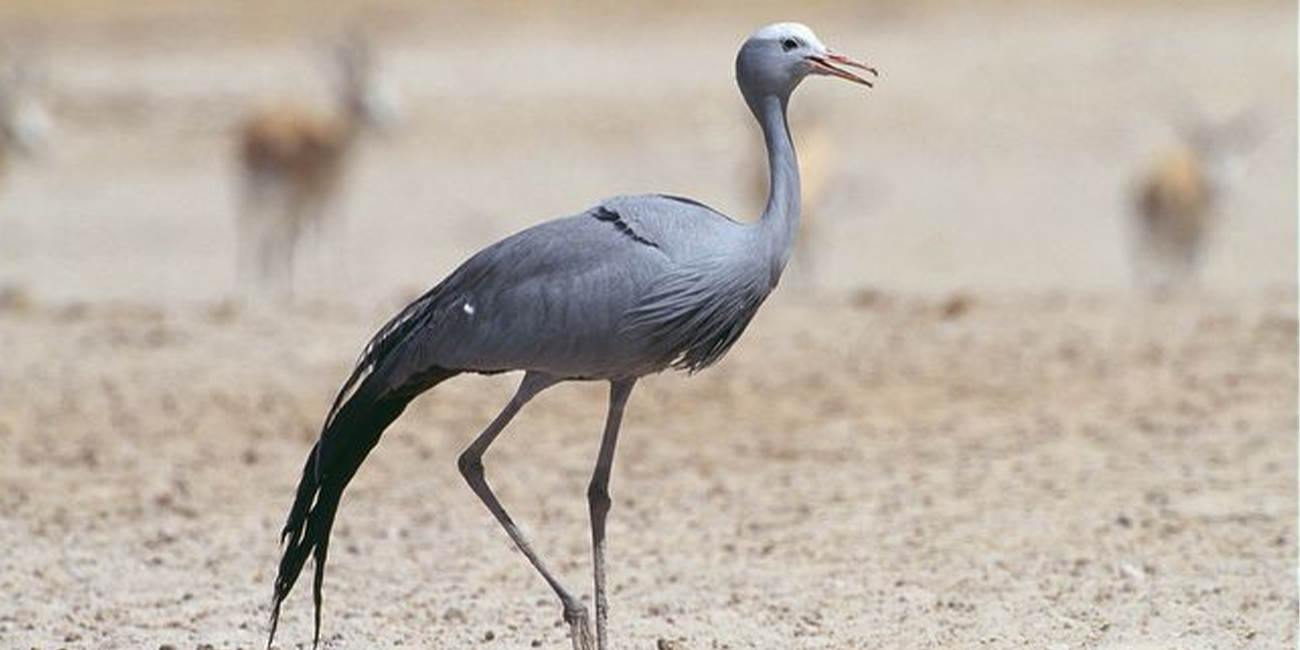How is South Africa’s national bird, the Blue Crane, doing?
By Christie Craig of the Endangered Wildlife Trust/International Crane Foundation, Fitzpatrick Institute of African Ornithology

In an ever-changing world, conservation scientists face the daunting task of keeping pace with the shifting dynamics of threatened species and adapting conservation action accordingly. This is especially true for South Africa’s national bird, the Blue Crane.
Historically, the Blue Crane’s population in its natural core range, the eastern grasslands and Karoo, suffered significant declines due to agricultural expansion and poisoning, leading to it being classified as Vulnerable on the IUCN Red List.
In contrast to the eastern side of the country, the Western Cape conversion of natural land (fynbos) to cereal agriculture and pasture was favourable for Blue Cranes and a new core population established and thrived there. Today, more than half of all Blue Cranes in South Africa are found in this intensively farmed landscape.
Despite this, there were major concerns about the sustainability of this population amidst the myriad threats posed by intensive agricultural practices. These are the questions I aimed to answer when completing my PhD. Between 2018 and 2023 we conducted field work to assess the distribution of the birds, their breeding success and predominant threats to the species. We also used citizen science data to determine population trends over the last 30 years.
Population estimates reveal a promising recovery of Blue Crane numbers since 2002. This is attributed to the recovery of grasslands due to ongoing conservation action, and Blue Cranes establishing a stronghold in the Western Cape.
However, this scenario changed in 2010 when Blue Crane numbers declined. Summer Coordinated Avifaunal Roadcounts showed that Blue Crane numbers dropped by 19% nationally between 2011 and 2019, particularly in the Overberg region where counts declined by 22%.
It was difficult to determine the exact cause of the decrease, and equally difficult to know whether it would continue. But, some clues as to where the problem may lie was sourced from survival and breeding data. Between 2016 and 2021 we fitted 31 satellite trackers to flighted Blue Cranes in the Western Cape.
From this data collected I was able to determine their survival rate, finding that 95% of breeding Cranes survive a given year, compared to 85% of non-breeding cranes. From the trackers we found that non-breeding cranes move significantly more (on average 9.5km per day) than breeding cranes (5.8km). This puts them at greater risk of dying as a result of collisions with powerlines and fences.
We also conducted extensive powerline surveys in the Western Cape and Karoo, walking or slowly driving 1,994km of powerlines to record collisions by Blue Cranes and other birds. We found that Blue Cranes were the most commonly recorded species, and collisions were particularly likely to occur if a powerline was within 2.5km of a seasonal waterbody. This is because Blues Cranes use shallow seasonal waterbodies to roost, and at low light they find it particularly difficult to circumvent powerlines. This knowledge will help us to, in future, better route powerlines and to proactively mark them to improve visibility. While there are significant casualties on powerlines, Blue Crane survival rates in the Western Cape are quite good compared to those found in regions such as the Karoo, and to other crane species outside South Africa.

This indicates that poor survival is not the primary reason for the population declining in this region. Rather, an alarm bell rang when I compared the breeding success of Western Cape cranes to past rates, and to rates in the Karoo and grasslands.
Recruitment of juveniles into the population is half of what it was in the Overberg 30 years ago. Swartland and Overberg Blue Crane breeding pairs successfully produce fledglings 43% and 40% of the time, compared to 68% of grasslands pairs and 67% of Karoo pairs. A caveat is that our data from the grasslands and Karoo is now over 10 years old, whereas the Western Cape data is recent, reiterating the need for continued monitoring.
Following a recent study showing that high temperatures and nest disturbance are risk factors for nest failure, we will need to actively work with land users to reduce disturbance at nests and give cranes their best chance at successfully raising young. The success of our long-term datasets for Blue Crane within South Africa is largely due to inputs by citizen scientists. Without this information we would not be aware of the decline in the Blue Crane population.
In 2023 we held a successful first Conservation Planning Workshop, facilitated by the Conservation Planning Specialist Group, to kickstart a process that will result in a finalised conservation plan when stakeholders meet again in October this year.
** A big thank you to Peter Ryan and Tanya Smith who supervised the PhD, and to Leiden Conservation Foundation, Eskom, Dave Myers, Hall-Johnson Fellowship and Bateleurs for supporting the research. We are grateful to the Leiden Conservation Foundation, Neuwied Zoo, Safari West and Jacksonville Zoo for sponsoring the conservation planning process.
